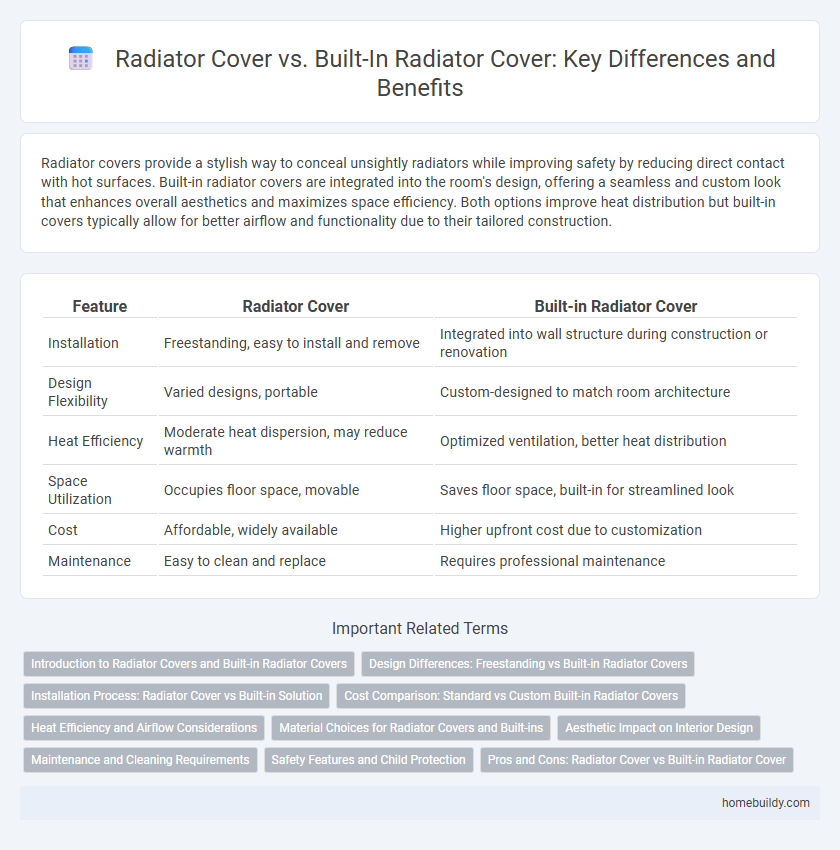Radiator covers provide a stylish way to conceal unsightly radiators while improving safety by reducing direct contact with hot surfaces. Built-in radiator covers are integrated into the room's design, offering a seamless and custom look that enhances overall aesthetics and maximizes space efficiency. Both options improve heat distribution but built-in covers typically allow for better airflow and functionality due to their tailored construction.
Table of Comparison
| Feature | Radiator Cover | Built-in Radiator Cover |
|---|---|---|
| Installation | Freestanding, easy to install and remove | Integrated into wall structure during construction or renovation |
| Design Flexibility | Varied designs, portable | Custom-designed to match room architecture |
| Heat Efficiency | Moderate heat dispersion, may reduce warmth | Optimized ventilation, better heat distribution |
| Space Utilization | Occupies floor space, movable | Saves floor space, built-in for streamlined look |
| Cost | Affordable, widely available | Higher upfront cost due to customization |
| Maintenance | Easy to clean and replace | Requires professional maintenance |
Introduction to Radiator Covers and Built-in Radiator Covers
Radiator covers serve as functional and decorative elements that enhance the appearance of traditional radiators by concealing them while allowing heat to circulate efficiently. Built-in radiator covers are custom-designed to integrate seamlessly with walls or furniture, offering a more permanent and streamlined solution compared to freestanding covers. Both types prioritize safety, heat distribution, and aesthetic appeal but differ primarily in installation style and design flexibility.
Design Differences: Freestanding vs Built-in Radiator Covers
Freestanding radiator covers offer flexibility in placement and easier installation, often featuring decorative panels that can be moved or replaced without altering the wall structure. Built-in radiator covers are integrated into the wall, providing a seamless look that maximizes space efficiency and can be customized to match architectural details. The design differences highlight freestanding options as versatile and temporary, while built-in covers create a permanent, streamlined aesthetic.
Installation Process: Radiator Cover vs Built-in Solution
Radiator covers typically offer a straightforward installation process, requiring minimal tools and no structural modifications, making them a convenient option for renters or those seeking a quick aesthetic upgrade. Built-in radiator covers, however, demand professional installation involving carpentry work and potential alterations to existing wall or floor structures, resulting in a more permanent and integrated solution. The choice between the two hinges on the homeowner's desire for ease of installation versus a seamless design integration.
Cost Comparison: Standard vs Custom Built-in Radiator Covers
Standard radiator covers typically cost between $50 and $200, offering affordable aesthetic improvement and basic protection. Custom built-in radiator covers range from $300 to $1,000 or more, depending on materials, design complexity, and installation requirements, providing a seamless and integrated look. Budget-conscious homeowners often prefer standard covers for immediate savings, while those investing in home upgrades opt for built-in versions to enhance value and style.
Heat Efficiency and Airflow Considerations
Radiator covers impact heat efficiency by potentially reducing the amount of heat radiated into the room, with built-in radiator covers often designed to maximize airflow and heat distribution more effectively than freestanding options. Built-in covers integrate ventilation elements such as mesh panels or slats that facilitate better air circulation, enhancing convection and maintaining room warmth. Considering airflow, built-in radiator covers minimize heat loss by directing warm air into living spaces, whereas standard covers may restrict airflow, leading to decreased heating performance.
Material Choices for Radiator Covers and Built-ins
Radiator covers typically use lightweight materials like MDF, plywood, or vinyl for ease of installation and cost-effectiveness, while built-in radiator covers favor durable materials such as hardwood or metal for long-lasting structural integration. MDF and plywood offer smooth surfaces ideal for painting and customization, whereas hardwood built-ins provide enhanced aesthetic appeal and strength suitable for permanent fixtures. Metal built-in covers enhance heat conduction and durability, making them a preferred choice in high-traffic or moisture-prone areas.
Aesthetic Impact on Interior Design
Radiator covers significantly enhance the aesthetic appeal of a room by transforming bulky radiators into sleek, visually pleasing elements that complement existing interior design styles. Built-in radiator covers integrate seamlessly with cabinetry and wall finishes, offering a cohesive and custom look that elevates the overall ambiance and architectural integrity of the space. Both options serve functional purposes, but built-in covers provide a more refined, permanent design solution that maximizes space efficiency and visual harmony.
Maintenance and Cleaning Requirements
Radiator covers require regular dusting and occasional deep cleaning to prevent dirt buildup, with simpler models offering easier access for maintenance. Built-in radiator covers often involve more intricate designs, making cleaning more challenging and sometimes necessitating professional servicing to maintain optimal airflow and efficiency. Choosing between the two depends on balancing aesthetic preferences with the practicality of routine upkeep.
Safety Features and Child Protection
Radiator covers and built-in radiator covers both enhance safety by reducing direct contact with hot surfaces, minimizing burn risks. Built-in radiator covers offer integrated child protection features such as tamper-proof design and sturdy construction, ensuring long-term safety in high-traffic areas. Radiator covers provide a portable safety barrier but may lack the permanent, secure fit that built-in options ensure for preventing accidental injuries.
Pros and Cons: Radiator Cover vs Built-in Radiator Cover
Radiator covers offer easy installation and portability, allowing for quick updates to room aesthetics, while built-in radiator covers provide a seamless, custom look that integrates with existing furniture or walls, improving space efficiency. Covers typically allow better airflow control and are often less expensive, but built-in options offer enhanced durability, increased heat distribution, and a cleaner finish. However, built-in radiator covers require professional installation and reduce flexibility for future modifications compared to standalone radiator covers.
Radiator cover vs Built-in radiator cover Infographic

 homebuildy.com
homebuildy.com